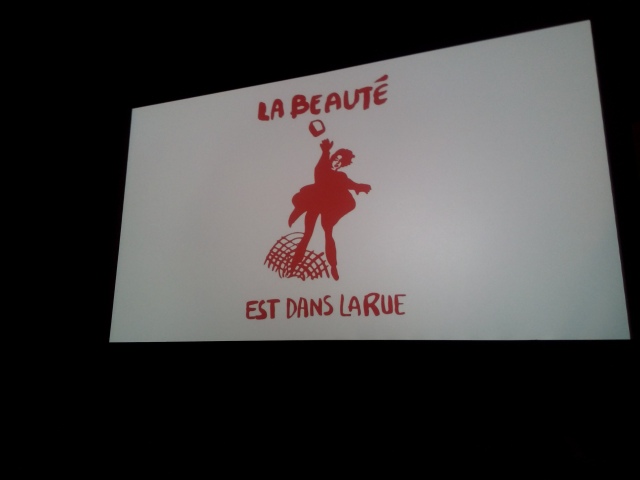Friday 9 June, 2017. Muzzy-headed after election night, panelists and participants for the final Salon of this season filed into the dark of the ICA’s cinema space for an afternoon of laughter and concern. As a panel on the Performance of Protest, this was to focus more on the thought that, as Aidan McGarry pointed out, democracy takes place beyond the ballot box. So what ever viewpoints on the election night before remain, the struggle goes on.
Beyond the ballot box is where attitudes and political viewpoints get changed, Aidan argued. It is where positions are played out in various locations and through various media. Performance is important in this. Often, this fills out cultural fissures — the unsuspecting gaps where we don’t necessarily expect political utterances — with challenging messages.
The panel itself was built on an AHRC-funded research project at the University of Brighton that is investigating the ‘Aesthetics of protest: Visual culture and communication in Turkey. This a country where, currently, there are sometimes heavy consequences to such acts. Pelin Başaran reminded us that deep strains exist at the backdrop to protest. In recent years in Turkey, over 100,000 civil servants have lost their jobs as a result of political tensions. Given the challenges of public protest, new spaces have to be found which both avoid issues of censorship but also by their very act may draw attention to the processes of censorship at the same time.
What are the choices? Presentations by Işil Eğrikaruk and Umut Korkut showed two complementary opposites. One is in the staging of complex, spectacular events that are absurd, playful and revealing. The other is in making an event of the mundane, where the simplest act becomes a radical gesture. It’s about context, of course.
In broad terms, Umut Korkut noted how authoritarianism may not necessarily disappear upon regime change. Drawing from his research in Hungary, he argued that while a backdrop of moving from command-economy state socialism to neoliberal models takes place, authoritative styles may remain and/or be extended. The use of absurdity therefore becomes a last resort in preserving hope and dignity — it outflanks the opposition.
The 2013 Taksim Gezi Park protests in Istanbul were undoubtedly important in the unfolding of various tactics of protest. The protests themselves stemmed from objections to a plan to demolish the park and build a shopping mall and luxury flats in its place.
However, beyond the concerns for the denigration of public space and environmental destruction, objections rippled out so that the Gezi Park was transformed into a symbolic space for the assertion of other positions (for instance, LGBT rights, rights to assembly or the defence of secularism). Within this, particular actions and objects became iconic: the ‘Lady in Red’; the makeshift gas mask (exhibited as part of the V&A’s ‘Disobedient Objects‘ show); the whirling dervish in gas mask. These became international, digital media events that were moved around the world that were associated with the Gezi Park protests but also a more general translation of concern into visual and material form. Ordinary acts — practising yoga, playing backgammon, having a conversation — were also assertions of humanity among the turbulence of that hot summer. If nothing else, this demonstrates the richness and breadth that is available in the aesthetics of protest.
‘Change Will Be Terrific!’ This is the title of an artistic project that Işil Eğrikaruk and Jozef E. Amado undertook in 2012. It involved a proposal to buy and exhibit the Pyramids, Parthenon and Palymira in Istanbul’s Taksim Square (before the Gezi Park issues kicked off, therefore). It culminated in a performance, photo series and rap that were presented through the medium of a TV chat show. Again, the political messages in this were multiple including the absence of new cultural developments in Istanbul and Turkey’s isolationism from its neighbours. This sophisticated project was full of twists and turns, unfolding in sometimes improvised ways as historical events caught up with it.
The close relationships of the spectacular and the mundane in the context of the aesthetics of protest seem inevitable. Borders between high and low cultural expression, the original and its serial reproduction or the functional and the symbolic are collapsed. Humour is poignant in both.
Politics and protest isn’t just about hard facts and figures but also bout capturing the imagination. Something, judging by the surprise of the UK election results and their aftermath, that Jeremy Corbyn succeeded in it seems.


